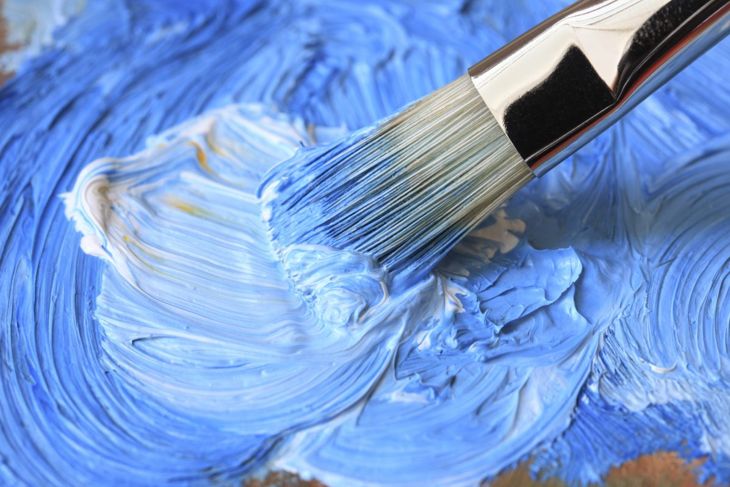How To Paint Clouds Oil
Big, open skies have long captured the human imagination. Have you spent more time than usual gazing at the sky lately or always admired landscape paintings and wondered how to paint clouds? There's nothing like the feeling of creating something with your own hands; anyone can create a calming and unique painting of the always-striking sky.
Choose your canvas
To create a decent-sized painting that will stand out in your home, a canvas no smaller than 12 x 14 inches is ideal. If you're new to painting, it's better to go for a larger rather than smaller surface, but avoid anything so big that it feels intimidating to even get started.

Arctic-Images / Getty Images
Gather your materials
You will need:
- A good-quality sketchpad
- Acrylic brushes. It's best to have different shapes and widths from 1/8 inch for finer detail up to a 1-inch brush for blocking in large areas.
- Acrylic paint: ultramarine blue, titanium white, warm gray, lemon yellow, raw umber.
- Water
- Easel
- Camera
- Charcoal or soft graphite pencil

wundervisuals / Getty Images
Take a good look
Forget about what you think clouds look like. When the weather cooperates, take twenty minutes to sit outside with your sketchpad and charcoal, wherever you are, and watch the clouds go by. Observe the regular and irregular shapes. Are they wispy "mackerel sky" clouds or classic cumulonimbus? Are they pure white and fluffy, or do they look heavy and gray, as though it could rain at any minute? What do you want your painting to portray?

Ascent Xmedia / Getty Images
Sketch with an open mind
Make rough sketches. Don't worry about perfection — just try to capture the basic shapes you see. This will be challenging as the clouds move, but that's half the fun. It's about capturing how the clouds make you feel, rather than trying to replicate them exactly. Think of it as a form of meditation.

Ascent/PKS Media Inc. / Getty Images
Take photographs
When you're done sketching, take a few photos of the clouds and print them out. These, along with your free-flowing sketches, will serve as your source material, but you have artistic license here: you can interpret the images any way you like. You're not going to copy them, you're going to be inspired by them!

stevecoleimages / Getty Images
Arrange your "studio"
Stick your photos and sketches up somewhere near your canvas and easel. Think about how you can translate these images onto your canvas to make a pleasing composition. Using your charcoal pencil, sketch in the largest shapes first: ovals, circles, oblongs — most clouds have soft edges. Don't worry if it looks rough. Use soft pressure to begin with. As you feel more confident, you can press a little harder so that you end up with rough outlines of the clouds.

Andrea Rugg / Getty Images
Mix it up
Now, create your colors. Think about the background, mid-ground, and foreground. Usually, the background is the blue of the sky itself. To make this, start with ultramarine blue and add other tones to it to make it look more natural. Usually, a little titanium white and a touch of gray make the blue paler and more muted. When you're happy with the color, add enough water that the paint will glide over the canvas easily. Make a note of the proportions of paint colors you used, so that you can mix more if you run out.

ROMAOSLO / Getty Images
Paint the sky
Generally, the sky appears bluer the higher you look, and fades to a pale blue-gray closer to the horizon, so you can blend a little more white and gray into the paint as you move down the canvas. Use long, horizontal strokes from left to right with your 1-inch brush. Note where the clouds will go. It's fine to go over them, so long as you can still see your charcoal pencil lines underneath. Allow this layer to dry.

Peter Cade / Getty Images
The high clouds
Next, you'll paint the high clouds. On fine days, these clouds can appear thin and fluffy, perhaps with a very slight blue tinge to them. To make these, mix the white paint with a tiny amount of the gray and blue. As you paint, think about the shapes you're trying to form. For wispier areas, use a small dry brush and a small amount of paint. Paint using small, curving motions. Remember to take a few steps back every so often, to see your painting with fresh eyes. This will allow you to see what's working well and what needs your attention.

Michael Dunning / Getty Images
Low-lying clouds
When the high clouds have dried, paint the clouds in the foreground. These appear slightly brighter and more defined than the clouds in the mid-ground. Mix up three slightly different shades: highlights, mid-tones, and shadow. Highlights are where the sun illuminates the cloud, usually around the top edges. For these, start with a large blob of titanium white, then add a hint of lemon yellow. For the mid-tones, do the same, but add a tiny amount of gray. Lastly, mix up a darker gray with a hint of white and a touch of raw umber. This will form the shadows that tend to fall on the underside of many clouds.
With a mid-sized brush, paint the majority of each cloud in the mid-tone shade. With a smaller brush, fill in the underside of each cloud with the darker gray. You can blend the two tones in places for a softer look. Lastly, paint in the highlights with the lightest shade, again blending with the mid-tone in places. Leave your artwork to dry, and display it with pride!

Grant Faint / Getty Images
How To Paint Clouds Oil
Source: https://facty.com/network/diy/painting-basics-how-to-paint-clouds/
Posted by: godinthemot.blogspot.com

0 Response to "How To Paint Clouds Oil"
Post a Comment